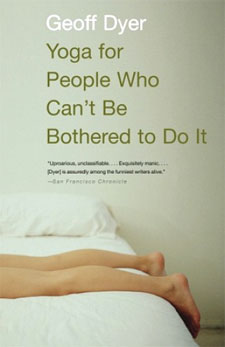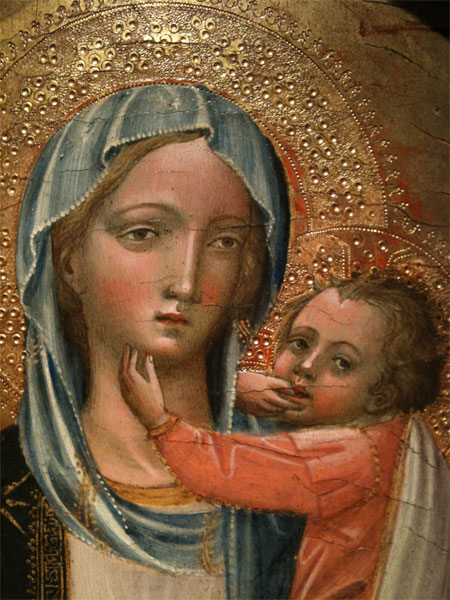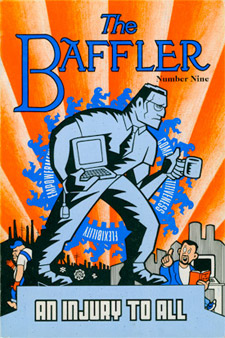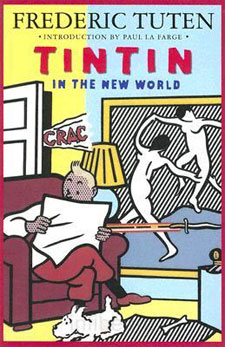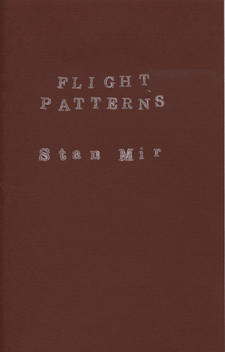 Chris Diken, Some People
Chris Diken, Some People
Stan Mir, Flight Patterns
(JR Vansant, 2009)
The number of people, I assume, who would buy books sight unseen from a press calling itself “JR Vansant” simply because it’s called that must be rather small; but I am in that number. Scott Bryan Wilson started publishing chapbooks under that name at the end of last year; my copies arrived last month. Production is straight-forward: silver type on heavy paper covers stapled around laser-printed interiors. The interior printing isn’t quite as nice as one might hope, and because of the long measure in Flight Patterns, the type is a bit small, but these are minor quibbles: this are very nice little books, better than I’d hoped for.
* * * * *
Chris Diken’s Some People is a short story, 18 pages long, and its plot is quickly related: a young man and woman visits an art museum, and the man uses the restroom. One is immediately caught by the style: the Gertrude Stein rhythm in the repetition of the fourth sentence:
They had hit a stride and each room in the museum seemed to reflect this overall greatening, each led them into a new age of new orientation of new medium of new dimension of new lender of new time of new overwhelming sense of standing before something ununderstandable yet still personally affecting.
Calling out Stein is something of a red herring. The dialogue in the story uses the Joycean dash; the voice is that of Gaddis, but more the Gaddis of The Recognitions than J R. There’s a little intrusion of Thomas Bernhard’s style if not his attitude: the long paragraphs, explanation piled on explanation; and maybe some David Foster Wallace. Another sentence, when the protagonist has found his way into the restroom, which he first wonders might be another exhibit:
As he went he though that while one arm had worked the flusher he’d used the other to undo himself with his free hand, thinking of himself in this situation as explicitly not free, that no one was free, that everyone was enchained by their urges, thinking of his free hand unjiggering his bebuttoned arrangement and of a three-dimensional model of the phrase free hand rotating like the precursor to human utterance in his mind, thinking how he used to be a mildly accomplished freehand sketcher before he gave it up for another pastime that too had passed, thinking that if only he didn’t find self-voiding the most horrendously outrageously horrible most distasteful and disgusting enterprise in the gamut of human activities that he could possibly take this opportunity to revisit his talent and how if he wasn’t in such a hurry to get it out and over with he could in a sense draw with his own acridity, employ self in lieu of stylus, practice here and then taken the honed skill to some more prominent canvas.
I like this sentence. It’s the italics that make me think of Wallace, but maybe the twisting baroque sentences of William Gass would be the best comparison. So much current fiction, especially fiction by young writers, tends to fall back on short, overly dramatic sentences: I feel like I don’t see long, wandering sentences like this enough: this is a sentence that’s trying to do something, and succeeding.
The protagonist of this story wanders into the bathroom wondering whether he’s left the art or whether he’s entering another exhibit; while at the urinal, a voice starts talking to him, engaging him in a conversation more philosophical than that of the typical bathroom voyeur. The possessor of the voice isn’t seen (and it’s unclear in the end whether he exists or not); the protagonist remains unsure whether he’s in the midst of some kind of performance. There’s an American suspicion of the visual arts: the fear that the crafty artist, probably European, might just be trying to trick us: it’s certainly at play in most of the descriptions of modern art in The Recognitions, for example. That’s certainly at play here. But there’s also a willingness to play along, to enter into a shared illusion, and I think that works here. It’s a good story: I’d like to see more from Chris Diken.
* * * * *
Stan Mir’s Flight Patterns couldn’t be more different: a long poem (32 pages of small type) identified on the website as the first part of an even longer poem, another section of which is scheduled to be printed in the future by JR Vansant. The subtitle identifies it as a “Poem Beginning with a Line from Lax,” the line (“Birds dart over us, pulling shadows through us“) presumably from Robert Lax, though I have to admit not knowing his work and I’m not sure about the attribution. This is a meandering, meditative piece: carried out to full length, it feels very much like it could have been a Jargon Society book. An excerpt of an earlier version appeared online in the oddly presented GutCult: this is approximately the first sixth of what’s in the book, with some differences: italics have been added, and a phrase deleted (“a bird ripped apart” in the third line of the first stanza of the second section).
The first section of this begins with a succession of thoughts, separated by colons, starting with birds and necessarily spreading onwards: the bird is a tremendously rich image, signifying an infinite number of different things. In the second section, the speaker’s voice appears: “I don’t / know where I belong nor where the pattern is”. From flocks of birds in the sky, the speaker takes his subject apart: “if change did occur // it did so long ago from the 3-fingered avian hand / flight’s feathers met modern birds’ basic form”. And then back to specifics: a warbler calling. Finally, a statement of purpose: “More things take flight / than we can count. I began with birds / to realize it’s more than birds.”
The style loosens up after this introduction and becomes more conversational. Sections of prose and quotations are placed in the text; there’s a loose narrative, a trip to a farm in Vermont. The speaker is writing Flight Patterns (perhaps in this metafictional nod, we see what unifies JR Vansant); his companion plays Chopin and he reads Robert Duncan. A stanza lists the proper names of birds, all evocative. The speaker’s mother and father are introduced; the history of the land comes in, an enduring concern of the poem. In an extended prose section, the scene changes to Arizona: and there’s more digging into the familial past. Current events intrude: the death of Saddam Hussein, when “an Airbus’ engines / ingested Geese over the Hudson.” We move back and forth: to Philadelphia, back to Vermont, into the recounted past, to Arizona. A bit of what seems to be Mormon history intrudes, as does the mystic Johannes Kelpius who settled in Germantown, Philadelphia. Birds glue everything together:
When my father handed me many things he handed me
my mother. At various times she has been a Mimic
Thrush or a Thrasher. Hardly ever has she been
a Laughing Thrush or a Babbler.
Since 1960 my father has hung like late autumn
Starlings in Rome, omnipresent & not quite
despised. Each November the Starlings come
in from the countryside & fly about
sometimes in the shape of lungs
sometimes in the shape of a fist.
It is impossible to get them to do
otherwise – this is their pattern.
The image of starlings in Rome strikes me as exactly perfect: that’s how I remember them there. This is a rambling work, and it’s hard to come to a judgment of it knowing that there’s more to come; but this section is self-contained, coming, finally, to a conclusion:
Poetry is not
the third eye
It is an eye
Word & voice
Voice may
not remain
The word a
recast image
in ruin
The bird’s
image darts
through us
The cicada
a shadow
pulling through
I like this; I suspect I’ll be coming back to this, and I’m interested in Mir’s other forthcoming books.
